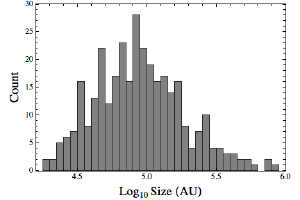Post
Twinkle Twinkle
Little Galaxy
8 August 2012
Last time I discussed quasars and other active galactic nuclei (AGNs), and noted how their intensity at radio wavelengths does not correlate with their intensity at visible wavelengths. This means that whatever these things are, they can’t simply be driven by some simple energy source, otherwise there should be some relation between radio and visible light. So there must be something more subtle going on.
Today we’ll get another clue by looking at a different aspect of these bright, distant objects, their varying brightness. The brightest quasar in our sky (in the visible spectrum) is one known as 3C 273. It’s redshift puts it at about 2.5 billion light years away. Because of its brightness and relative closeness, it is one of the most studied quasars. So we actually have quite a bit of data on it. One of the things we’ve observed is that its brightness oscillates over time. Basically the quasar “twinkles”, getting slightly brighter and dimmer about 15 times a year. We see this variability in other quasars, but 3C 273 is the most accurately measured.
A varying brightness is interesting because it tells us something about the size of the source. Basically if an object is changing brightness, it can’t do that at a rate faster than the time it takes one side of the object to know what the other side is doing. That time is limited by the speed of light, so if you know the rate at which brightness varies, you know the maximum possible size of the object. Since these objects are also greatly redshifted we have to account for that as well (high redshift means time dilation), but that’s pretty easy to do. So we can take our quasar and AGN observations and calculate a maximum size for each one.
 Brian Koberlein
Brian KoberleinThis is what I’ve done in the figure here. Plotting how many are at each particular size. While they vary in size, the maximum size is most commonly around 5 on this graph, which equates to 100,000 AU, or about 1.5 light years across.
That seems pretty big, but remember that these objects are brighter than our galaxy (consisting of 200 billion stars). On a galactic scale these objects are tiny. Given their large brightness and tiny size, we can say with confidence that they are not driven by some sort of fusion process. They can’t be stars, or supernova, or something like that, because they are simply giving off too much energy from too little volume. Instead they have to be driven by something more powerful.
Next time we’ll figure out what that something is.